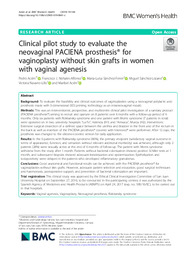Por favor, use este identificador para citar o enlazar este ítem:
https://hdl.handle.net/11000/33433Registro completo de metadatos
| Campo DC | Valor | Lengua/Idioma |
|---|---|---|
| dc.contributor.author | Acién, Pedro | - |
| dc.contributor.author | Nohales-Alfonso, Francisco J. | - |
| dc.contributor.author | Sánchez-Ferrer, María Luisa | - |
| dc.contributor.author | Sánchez-Lozano, Miguel | - |
| dc.contributor.author | NAVARRO LILLO, VICTORIA | - |
| dc.contributor.author | Acién, Maria Isabel | - |
| dc.contributor.other | Departamentos de la UMH::Ingeniería Mecánica y Energía | es_ES |
| dc.date.accessioned | 2024-10-07T08:30:50Z | - |
| dc.date.available | 2024-10-07T08:30:50Z | - |
| dc.date.created | 2019 | - |
| dc.identifier.citation | BMC Women's Health (2019) 19:144 | es_ES |
| dc.identifier.issn | 1472-6874 | - |
| dc.identifier.uri | https://hdl.handle.net/11000/33433 | - |
| dc.description.abstract | Background: To evaluate the feasibility and clinical outcomes of vaginoplasties using a neovaginal polylactic acid prosthesis made with 3-dimensional (3D) printing technology as an intraneovaginal mould. Methods: This was an interventionist, prospective, and multicentre clinical pilot investigation of a sanitary product (PACIENA prosthesis®) aiming to recruit and operate on 8 patients over 6 months with a follow-up period of 6 months. Only six patients with Rokitansky syndrome and one patient with Morris syndrome (7 patients in total) were operated on in two university hospitals: “La Fe”, Valencia (H1) and “Arrixaca”, Murcia (H2). Interventions: Extensive surgical dissection of a defined space between the urethra and bladder in the front and of the rectum in the back as well as insertion of the PACIENA prosthesis® covered with Interceed® were performed. After 12 days, the prosthesis was changed to the silicone-covered version for daily application. Results: In the 6 patients with Rokitansky syndrome (86%), the primary endpoint (satisfactory vaginal outcome in terms of appearance, function, and sensation without relevant additional morbidity) was achieved, although only 2 patients (28%) were sexually active at the end of 6 months of follow-up. The patient with Morris syndrome withdrew from the study after 1 month. Patients without bacterial colonization showed positive Schiller tests at 1 month, and subsequent biopsies showed adequate keratinization and epidermization. Epithelization and iodopositivity were delayed in the patients who developed inflammatory granulomas. Conclusions: Good anatomical and functional results can be achieved with the PACIENA prosthesis® for vaginoplasties without skin grafts. However, adequate patient selection and education, good surgical techniques and haemostasis, postoperative support, and prevention of bacterial colonization are important. Trial registration: This clinical study was approved by the Ethical Clinical Investigation Committee of San Juan University Hospital on September 27, 2016, to be conducted in the participating centres; it was authorized by the Spanish Agency of Medicines and Health Products (AEMPS) on April 24, 2017 (exp. no. 585/16/EC), to be carried out in that hospitals. | es_ES |
| dc.format | application/pdf | es_ES |
| dc.format.extent | 10 | es_ES |
| dc.language.iso | eng | es_ES |
| dc.publisher | BMC | es_ES |
| dc.rights | info:eu-repo/semantics/openAccess | es_ES |
| dc.rights | Attribution-NonCommercial-NoDerivatives 4.0 Internacional | * |
| dc.rights.uri | http://creativecommons.org/licenses/by-nc-nd/4.0/ | * |
| dc.subject | Vaginal agenesis | es_ES |
| dc.subject | Vaginoplasty | es_ES |
| dc.subject | Neovaginal prosthesis | es_ES |
| dc.subject | Rokitansky syndrome | es_ES |
| dc.subject.other | CDU::6 - Ciencias aplicadas::62 - Ingeniería. Tecnología | es_ES |
| dc.title | Clinical pilot study to evaluate the neovaginal PACIENA prosthesis® for vaginoplasty without skin grafts in women with vaginal agenesis | es_ES |
| dc.type | info:eu-repo/semantics/article | es_ES |
| dc.relation.publisherversion | https://doi.org/10.1186/s12905-019-0841-z | es_ES |

Ver/Abrir:
s12905-019-0841-z.pdf
3,56 MB
Adobe PDF
Compartir:
 La licencia se describe como: Atribución-NonComercial-NoDerivada 4.0 Internacional.
La licencia se describe como: Atribución-NonComercial-NoDerivada 4.0 Internacional.
.png)